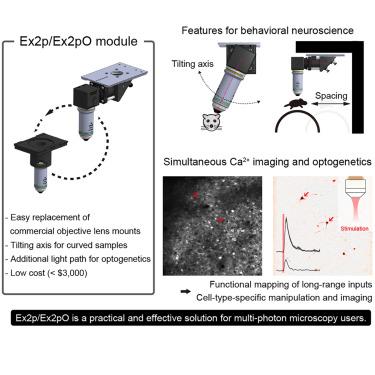扩展模块的双光子显微镜,使灵活的体内成像和全光学生理
IF 4.1
2区 综合性期刊
Q1 MULTIDISCIPLINARY SCIENCES
引用次数: 0
摘要
双光子成像对于揭示各种细胞类型的结构、功能和相互作用是必不可少的。然而,传统的双光子显微镜在成像过程中的样品可及性和光遗传操作方面存在局限性。在此,我们提出了一个开源扩展模块Ex2p/Ex2pO,它在双光子显微镜中增加了一个物镜旋转轴和与共振扫描非成像间隔同步的单光子光学刺激。Ex2p/Ex2pO可以无缝集成到现有的显微镜,只需更换标准物镜组件,无需任何修改。它可以在保持受试者自然姿势的同时对弯曲结构进行成像,同时进行成像和单光子刺激,刺激和荧光灯之间的串扰很低。我们在虚拟现实环境和多能干细胞衍生的皮质类器官的双光子成像中展示了单光子刺激。因此,Ex2p/Ex2pO扩展了多功能性,可以研究行为动物和类器官的神经回路基元,使现有双光子成像系统中的全光学生理学成为可能。本文章由计算机程序翻译,如有差异,请以英文原文为准。

An extension module for a two-photon microscope enables flexible in vivo imaging and all-optical physiology
Two-photon imaging is essential for revealing the structure, function, and interaction of various cell types. However, conventional two-photon microscopes have limitations in sample accessibility and optogenetic manipulation during imaging. Here, we present Ex2p/Ex2pO, an open-source extension module that adds an objective lens rotation axis and one-photon optical stimulation synchronized with the non-imaging intervals of resonant scanning to a two-photon microscope. The Ex2p/Ex2pO can be seamlessly integrated into existing microscopes by simply replacing the standard objective lens assembly without any modifications. It enables imaging of curved structures while maintaining the subject’s natural posture and simultaneous imaging and one-photon stimulation with low crosstalk between stimulation and fluorescent light. We demonstrate one-photon stimulation during two-photon imaging of mice behaving in a virtual reality environment and pluripotent stem cell-derived cortical organoids. Thus, Ex2p/Ex2pO expands the versatility to investigate neural circuit motifs in behaving animals and organoids, enabling all-optical physiology in existing two-photon imaging systems.
求助全文
通过发布文献求助,成功后即可免费获取论文全文。
去求助
来源期刊

iScience
Multidisciplinary-Multidisciplinary
CiteScore
7.20
自引率
1.70%
发文量
1972
审稿时长
6 weeks
期刊介绍:
Science has many big remaining questions. To address them, we will need to work collaboratively and across disciplines. The goal of iScience is to help fuel that type of interdisciplinary thinking. iScience is a new open-access journal from Cell Press that provides a platform for original research in the life, physical, and earth sciences. The primary criterion for publication in iScience is a significant contribution to a relevant field combined with robust results and underlying methodology. The advances appearing in iScience include both fundamental and applied investigations across this interdisciplinary range of topic areas. To support transparency in scientific investigation, we are happy to consider replication studies and papers that describe negative results.
We know you want your work to be published quickly and to be widely visible within your community and beyond. With the strong international reputation of Cell Press behind it, publication in iScience will help your work garner the attention and recognition it merits. Like all Cell Press journals, iScience prioritizes rapid publication. Our editorial team pays special attention to high-quality author service and to efficient, clear-cut decisions based on the information available within the manuscript. iScience taps into the expertise across Cell Press journals and selected partners to inform our editorial decisions and help publish your science in a timely and seamless way.
 求助内容:
求助内容: 应助结果提醒方式:
应助结果提醒方式:


